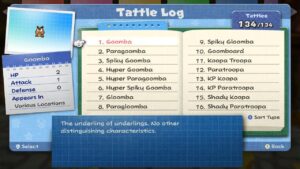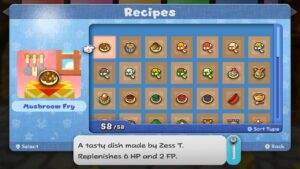When it comes to the Paper Mario series, the last decade hasn’t exactly been a great one for the franchise. Oh sure, the games certainly existed.
But they weren’t exactly what the fanbase wanted. Instead of being the carefully crafted story driven RPGs people were hoping for, they were instead artsts and crafts themed puzzle adventure games, with the characters and settings so beloved by fans replaced by nothing more like New Super Mario Bros era mainstays in the process.
It was a bad time for the series for sure, and one which only got a little better with Color Splash and Origami King.
But now it seems like that era might finally be at an end. Why? Because not only did Nintendo release a full-blown remake of Paper Mario: The Thousand Year Door on Switch, but we can confirm without a doubt it’s everything the fanbase have wanted and more.
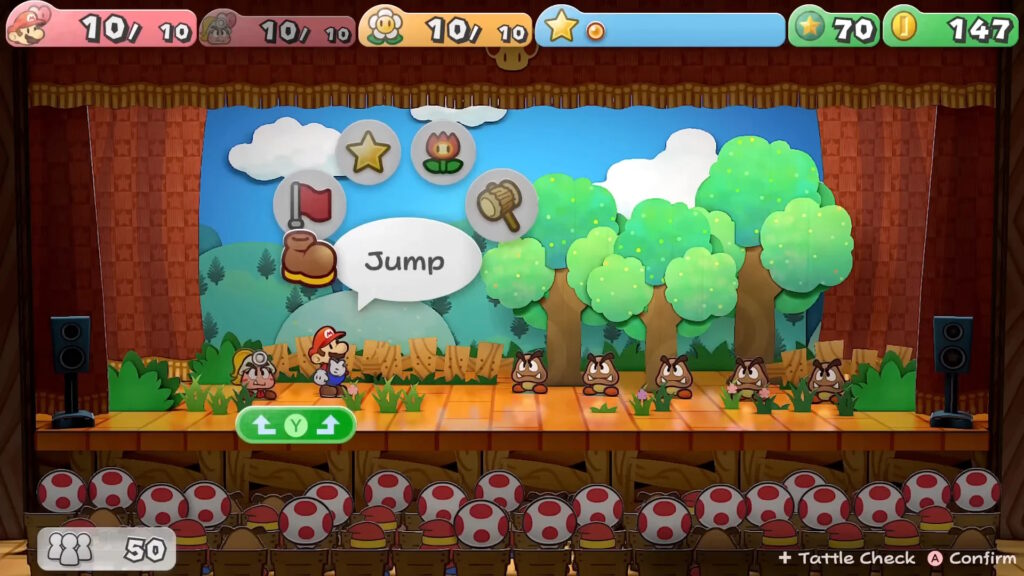
The remake of Paper Mario TTYD is still as fun as ever
In fact, Paper Mario: The Thousand Year Door on Switch actually feels like a brand-new game now, with some of the most impressive visuals and music on the console, and gameplay that takes all the original’s goodness, then irons out the last remaining flaws here and there.
With the first thing you’ll notice being the visual upgrade. Wow, talk about an overhaul here!
Seriously, this game looks incredible on Switch. The characters are as charming as ever, and now have more animations than ever before. The areas you explore have the right mix of realism and papercraft aesthetic to keep them exciting, and overall, it just looks like a stunning game. In fact, if you didn’t tell us this was a remake, we’d probably think it was a brand-new Paper Mario title!
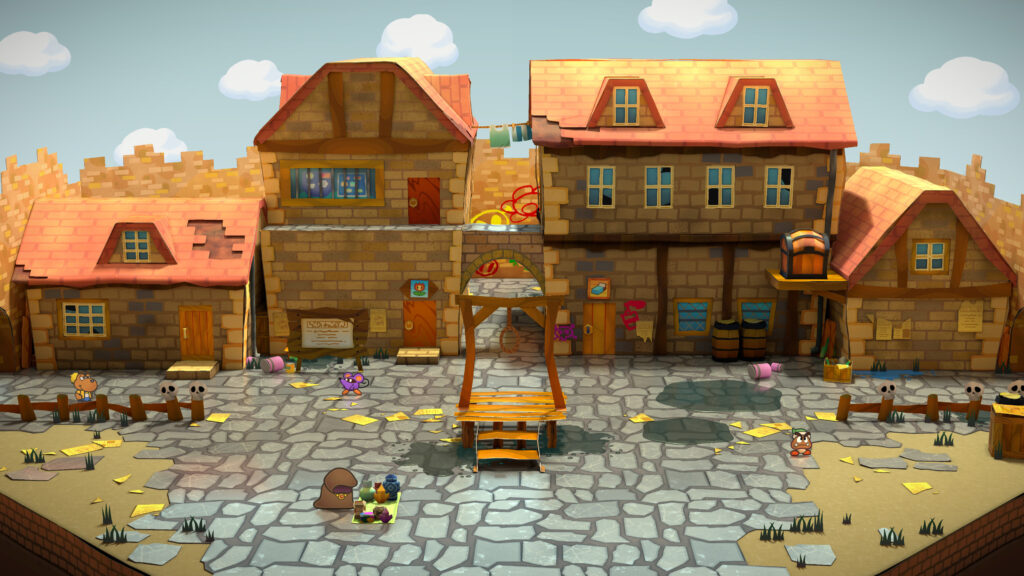
As seen by Rogueport from the intro, which now looks better than ever
Unfortunately, that beauty does come with a price. Aka the frame rate.
Since unlike the original GameCube game, this remake runs at only 30fps. It’s not a huge deal overall, and it doesn’t really harm the experience in any particularly noticeable ways…
But it is disappointing nonetheless, especially if you don’t have a hacked Switch able to run the restoration mod.
Still, given it’s an RPG rather than an action game, the frame rate change isn’t the end of the world.
Especially given that various other parts of the game got an overhaul too. Like say, the music.
And wow, what an improvement it is in that department. Okay, your mileage may vary on some of the remixes. They’re not gonna be to everyone’s taste after all.
But damn, they gave this game the full Origami King treatment here. Every single song has been redone with what seem like live (or at least much higher quality) instruments, with all kinds of extra parts added to each tune. It’s impressive to see (or hear), and takes what was already an epic soundtrack and makes it even more so.

Especially when you consider just how much new music the game has to.
You see, the original Paper Mario 2 didn’t have much unique music for battles or locations. As a result, pretty much every normal battle in the game would use the same general theme, and a good chunk of the bosses reused music from each other too.
That’s not the case here in the remake. Oh hell no.
Now, every area has its own battle theme specific to its setting! The Boggly Woods one has a more mystical flavour, the Glitz Pit one feels like a televised showdown in a wrestling ring and chapter 6 has a swing type rendition to go with Riverside Station.

It’s incredible really, and really makes things feel far more unique throughout the adventure.
What’s more, it’s not even limited to one new battle theme per area either.
Oh no. Sometimes, various sub areas will have their own themes too.
Like how the moon has a disco remix of the battle theme while you’re there, or how the dungeons seem to have an epic rendition of the theme filled with ominous chanting. How each of the dragons has their own unique take on the Hooktail boss theme. How Doopliss’ fake Mario form has its own battle theme.

Or how each sub area has its own slightly different variant of the main area theme. Yep, there are now multiple renditions of the X-Naut Fortress theme based on where you are in the base, and all of them sound amazing.
To say it’s a massive improvement would be a serious understatement in every way. It really is awesome to see, and turns the Thousand Year Door soundtrack from a great one to something that might actually rival The Origami King for the best soundtrack in the series.
But enough about the aesthetics for now. Good graphics and music are nice to see and all, but they don’t make a great game in of themselves. So how does the actual gameplay compare? Does it still hold up in 2024?
Absolutely.
Paper Mario: The Thousand Year Door feels as fun to play now as it did back in the GameCube era.
And that’s because everything just kinda works in this format. The battles are fun, and keep you wanting to fight everything you see. The overworld areas are fun to explore, with all manner of interesting characters to interact with. And unlike the later games… there’s never anything that makes replaying the game a chore.
It’s the pinnacle of the Paper Mario formula, and a game whose sequels have never come close to matching, let alone besting.
Still, for those who haven’t played the original, how does it work?
Well, as far as overworld exploration goes, kinda like a cross between a 3D Mario platformer, a Zelda game and a traditional RPG. It does this by having a chapter system with the following format:
- You go to a new area, as shown on the Magical Map
- This area has an entirely unique look and feel to it, with a new set of characters to interact with and lots of new enemies to fight
- There, you learn there’s a problem affecting the area, and the Crystal Star is usually connected to said issue (by means of the antagonists holding it, looking for it or using it for nefarious purpose)
- You explore the area and team up with a new partner, whose abilities can be used to solve puzzles and make progress
- This leads to a dungeon where what you’ve learnt is truly put to the test
- And at the end, there’s a boss to fight with its own unique attack pattern
- One Crystal Star down, onto the next
It’s a tried and tested formula, and one which has somewhat been present in every other Mario RPG in the series.
But it works best here, since the partners are actually relevant throughout the entire game. Unlike The Origami King, where they join you for a bit and drop out of the story, they’re with you the whole way here. Their abilities are usually needed to unlock the next area, and used for lots of other puzzles and obstacles throughout the rest of the game too.
Add this to their distinct personalities, and well, you’ve got a set of partners which are the best in the series.
Yet while the overworld mechanics are fun, it’s the battle system where this game’s uniqueness shines through. Oh sure, you’ve got most of the standard Mario RPG tropes here.
There are turn based battles with action commands to pull off. You can block or deflect enemy attacks by pressing a button as they’re about to hit you. And the usual Mario universe items all show up…
But there’s a whole stage show/audience setup in play too. Now, the audience watches every battle in the game, and interacts with things in a very unique way. They’ll give you star power by cheering, which happens when you successfully perform attacks or appeal to them via the relevant command. This power is then used for the abilities granted by the crystal stars, which are either powerful attacks that can wipe out hordes of enemies in record time (Earth Tremor, Art Attack, Showstopper, Supernova) or useful support moves that can change the tide of battle (Sweet Feast/Treat, Clock Out, Power Lift). So, if you want to use them, you’ll need to do well in battle to restore the meter.
And part of that also comes down to stylish moves too. You see, if you press A at the right time during a move, Mario or his partner will pose or backflip or show off too, which gains even more star power as a result. It really adds a nice extra layer of complexity here too.
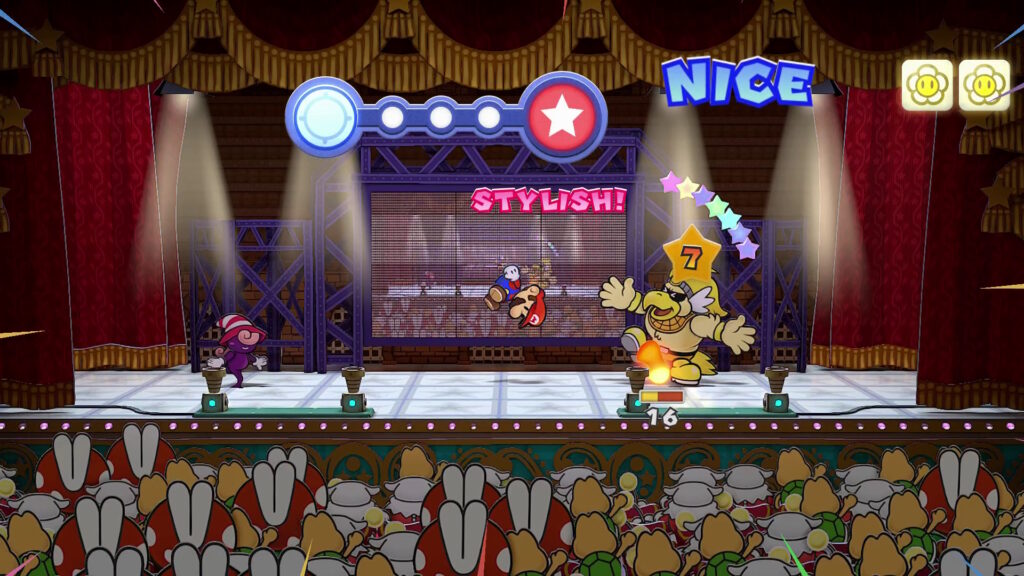
Stylish moves add a nice layer of complexity to the proceedings
Yet the stage show antics don’t end with star power. No, this game’s battle system is a stage show gone insane, with all manner of random jokes and gimmicks made possible as a result of this.
For example, the arena itself might fall apart mid battle. This causes effects ranging from the backdrop falling on the player or their enemies to jets of fire or ice burning or freezing a random combatant. As you can imagine, these do damage or inflict status effects, which can completely change the tide of a tough battle.
Meanwhile, the audience itself is a bit of a rough lot too. As a result, they’ll often throw items at Mario mid battle, ranging from helpful goodies you want to pick up to dangerous projectiles like rocks and litter. In response to this, Mario or his partner can then jump off stage and fight them off, which either does nothing too serious (if they scared away a heckler) to scaring off more of the audience (if you accidentally attacked someone trying to throw you a helpful item).
Add this to the audience themselves occasionally jumping on stage to cause havoc, the audience getting scared away or even killed by other members or events, and certain bosses outright attacking the audience to restore health or get ammunition…
And you have one heck of a crazy battle system where chaos can ensue at the drop of a hat and your surroundings can play as big a part in the proceedings as your own party.
There’s also the level up system too. Unlike many RPGs, you don’t see your stats increase automatically in this game. Instead, you get to choose whether to increase your HP, FP or BP after each level up, with the ones chosen changing the game dramatically.
It’s an interesting setup, and one with plenty of fun trade-offs to suit every playstyle. Do you want to play defensively, and have Mario try to stay alive as long as possible? If so, then increasing your HP each time can work just fine. Like special attacks and want to use a ton of them? Then increasing your FP just be the order of the day.
And if you like badges, then increasing BP lets you equip more of those too.
Speaking of which… yeah, that’s a whole interesting subject in of itself right there.
You see, the badge system in this game, is a lot closer to a full-blown character customisation system in many others. You have a limited number of BP, and each badge costs a certain amount of it. These badges in turn give Mario new abilities, change his stats or attributes, or even revamp various parts of the game’s mechanics as a whole.

For example, Spike Shield and Ice Power let you jump on spiky or fiery enemies respectively, turning them from foes you have to use a hammer against into ones which can be fought with any style of attack.
While the likes of Power Bounce, Power Jump, Hammer Throw and Quake Hammer add entirely new moves to his arsenal, letting you significantly expand his moveset from a couple of normal jumps and hammers to dozens upon dozens of creative variants. There’s a setup for everyone here, and it almost guarantees that no two players are going to tackle the game the same way.
So mechanically wise, Paper Mario: The Thousand Year Door is as awesome as ever, and holds up brilliantly in 2024.
Which is also really true of the story too. Like with Super Mario RPG, this is another comedic game that’s just as entertaining to experience in 2024, with nay an outdated or unfunny joke in sight. And humour aside, it’s a great story in general too.
With the main gist of it being that while travelling, Peach comes across the Magical Map, a treasure map that shows the locations of the crystal stars. These objects can be used to open the Thousand Year Door beneath Rogueport, behind which a legendary treasure is said to be found.
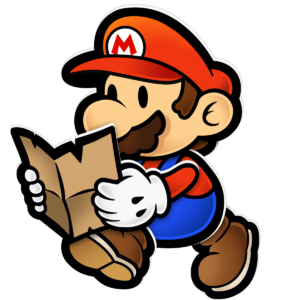
Of course, this being a Mario game, things aren’t quite that easy. Mere seconds after Peach sends the map to Mario, she gets kidnapped, and it’s up to our favourite plumber to figure out where she is, and what her captors want her and the crystal stars for. It’s a pretty typical plot for an adventure game overall, but one which is told masterfully here, with a great cast of charming and loveable characters you meet along the way.
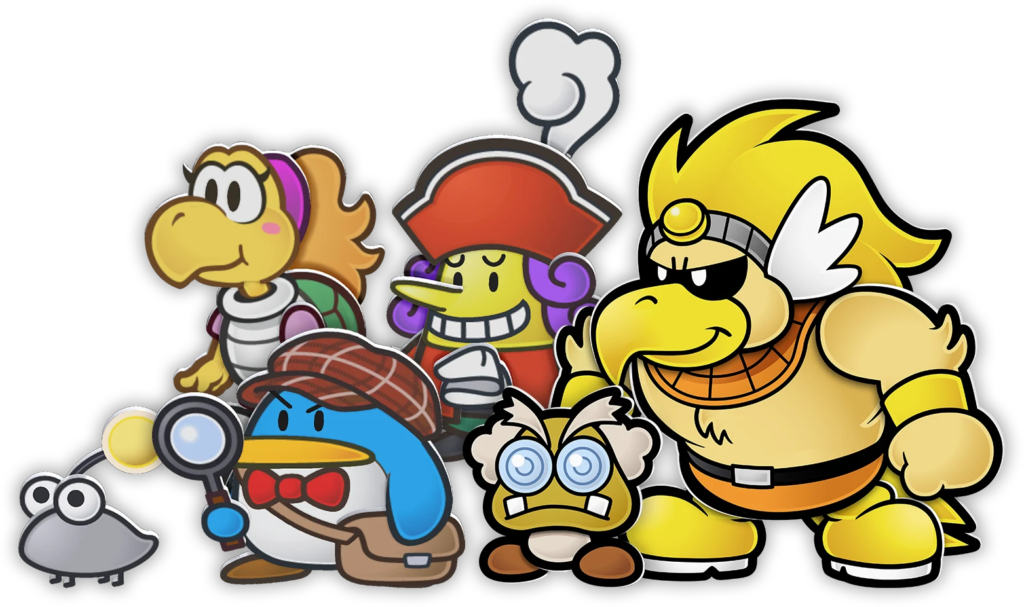
These are just some of the many awesome characters you’ll meet on your journey
And it’s made even better by the fact that each chapter is a story of its own. One which usually parodies the conventions of a particular plot type or genre.
For example, your first chapter has you trying to stop a dragon that’s guarding the crystal star to save the townsfolk and find out what happened to the father of one of your partners, while others have you investigating a curse that turns people into pigs when a bell tolls, or exploring a tropical island to find the treasure trove of a legendary pirate.
It’s all very creative, and means that a new player is never going to be sure what they’ll encounter in each chapter until they get there.
However, the most interesting two of the bunch are definitely chapters 3 and 6. The latter is a train ride to Poshley Heights, with each day of the journey being a different mini story in itself (a bunch of Murder on the Orient Express style mysteries, a stop-off at a dungeon at Riverside Station and a third we won’t spoil here). While the former is a pro wrestling pastiche, with Mario having to fight his way to the top of the league at the Glitz Pit and discover why fighters are going missing behind the scenes.
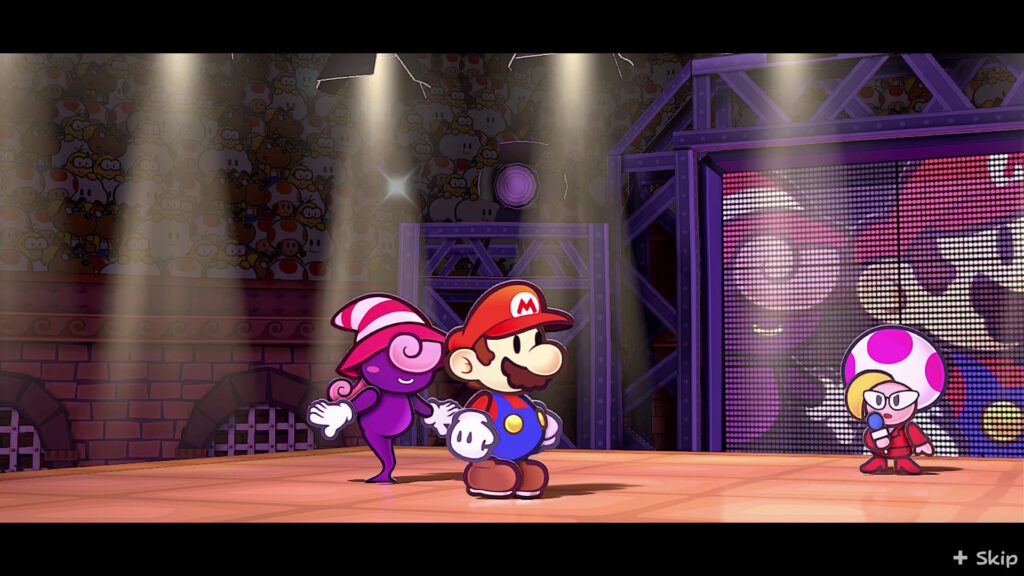
Chapter 3 is one of TTYD’s best chapters, and takes place in the Glitz Pit wrestling arena
They’re two awesome chapters, and honestly two of the best areas we’ve ever seen in a video game, period.
There’s also the matter of the Peach and Bowser intermissions too. You see, once you finish a chapter with Mario, you don’t just go straight back to Rogueport to begin the next one.
No, you get to see what Peach and Bowser are up to as well. And these intermissions are a fun little novelty.
On Peach’s side, they’re basically just mini puzzle solving adventures. You wake up in the antagonist’s main headquarters, and you’re tasked with doing various things to find out more information about their plans. They’re a moderately fun time the first time around, given how interesting the space station setting is and how much personality the characters you interact with have (like the base’s main computer TEC-XX), but they’re arguably inferior to those in the original Paper Mario on a gameplay level, since there are no consequences for any of your actions. You can’t get caught by enemies or fail any of your tasks, and just about everything can eventually be done mindlessly via trial and error.
They’re still fun, but a tad less interesting than they probably could be.
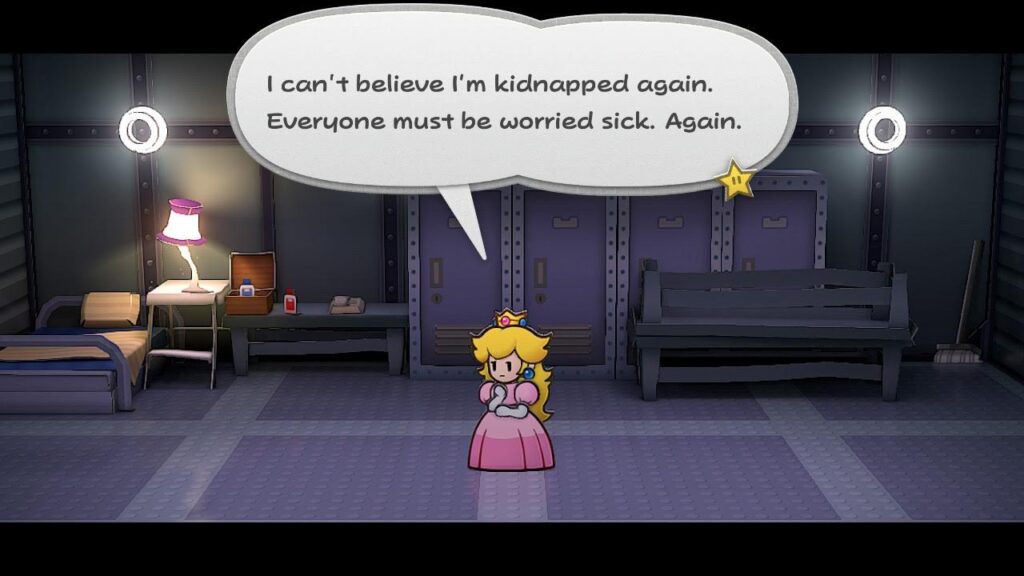
Peach’s sections are a fun novelty, though a tad simplistic
Meanwhile, Bowser’s segments are arguably the more interesting ones. In these sections of the game, you play as Bowser as he explores the same settings Mario and co did a couple of chapters ago, interacting with many of the same characters in the process.
And these are in our opinion, probably some of the funniest parts of the whole adventure. This is in large part because of how out of place Bowser and Kammy Koopa are in these locations, and how ridiculous everyone’s reactions are to them as a result. You can call yourself a legendary businessman or Koopa mayor to strike fear into people’s hearts. Get into a comedic argument with the equally goofy Lord Crump and his X-Naut minions, wonder how everyone else is getting Crystal Stars due to side characters not knowing Mario’s name…

But Bowser’s are awesome, due to the hilarious dialogue
Plus play through mini side-scrolling levels inspired by the original Super Mario Bros, except with Bowser as the main protagonist. They’re all great fun, and vary up the story quite a bit as a result.
Still, you may now be wondering something about this whole thing. About why we’re spending so much time on things the original GameCube game did, rather than those exclusive to the remake.
And that’s because for the most part… there isn’t actually all that much that is exclusive to the remake.
Okay, you’ve got the aesthetic improvements mentioned earlier, and there are tons of nice quality of life improvements here and there…
But for the most part, this is Paper Mario: The Thousand Year Door as it was in 2001, just with an extra nice lick of paint.
Which in this case is exactly what the original game needed. You see, Paper Mario: The Thousand Year Door is not a game that has much room for new content or obvious improvements. Every beat of the plot is as well-explained as it could ever be, every chapter does exactly what it needs to do, and the mechanics just generally hold up very well two decades later.
So, Nintendo didn’t really need to do anything crazy here. Short of remaking Luigi’s entire side story Bowser’s Fury style, there’s not really any place for additional content to fit into this title.
Hence the only major content changes are two new optional bosses, and everything else is restricted to fixes for the few issues the original title did have. The warp system has been revamped, with a convenient pipe room accessible from the middle of Rogueport instead of the clunky setup from the GameCube game. The backtracking in places like Twilight Town and Keehaul Key has been reduced, with extra pipes and springboards to provide shortcuts…
And there are other small tweaks to remove annoyances from the original, like an Exhibition Match system in the Glitz Pit to refight previous battles for Tattle Log entries.
It’s merely a better, cleaned up version of Paper Mario 2, and that’s all it ever needed to be.
Well, for the most part. There are a few negative aspects we feel probably could have been improved on, albeit rather minor ones.
Such as the game’s sidequests. Why? Because almost every single one of them involves a location called the Trouble Centre.
This is where NPCs post their problems, and Mario can sign up to help them. It’s a cool concept, and it definitely helps centralise all the game’s sidequests…
But it has a lot of problems too. For one thing, you can only take on one trouble at a time.
Meaning that you’ll need to backtrack a lot to 100% complete the game. After all, multiple sidequests happen in each of the game’s locales, and most of them involve you travelling between a couple of them rather than staying in a single place.
So you end up wasting a lot of time due to being unable to batch up quests or journeys, slowing the system to a crawl in the process.
There are also few good rewards for finishing these troubles either. Okay, Ms Mowz’s sidequests have her join Mario’s party, and a couple of the others give you cards to play mini games at the Pianta Parlor…

Ms Mowz (the character shown here) will join your party after one sidequest
But the vast majority reward you with coins, and barely any of them at that. In a game where money is literally falling from trees and a trip through the Pit of 100 Trials can get you thousands of coins, being rewarded 30 coins for trekking across the entire world feels like a complete rip-off, especially given how long that journey can take.
And unfortunately, this is sometimes required for new content too. You see, at least one of the new bosses doesn’t just pop up on their own as you progress the story.
No, you have to complete a specific, unmarked trouble for that to happen. So, if like me you avoided the Trouble Centre for most of the game because it was a waste of time…
Well, you’re gonna need to grind through it all to experience said new battles. It’s not fun, and honestly makes us wish these battles were just tied to story progression instead.
The game’s also a tad easy too.
And to a degree, we get that. Mario RPGs in general tend to be on the easy side, since they’re designed as a new player’s introduction to the genre as a whole. Hence you don’t really need to strategise much here, nor are there many parts of the game that’ll truly test you to your limits.
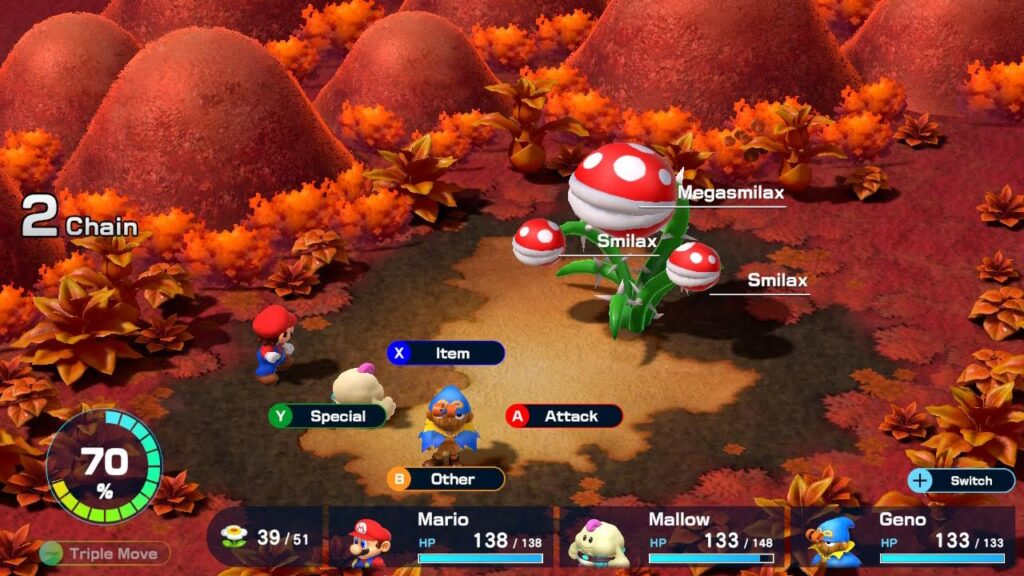
Super Mario RPG was a similarly easy game
And while that’s fine overall, it does mean that experienced players are going to plow through the game in record time due to the lack of a hard mode or anything similar. It was designed for new players whose knowledge of tactics starts and ends with “hit things until they fall over”, and any sort of optimised character build will tear everything to shreds because of it.
Still, at least the new content is on the tougher side there. The new bosses are a great challenge in this remake, and a true test of your skill unlike almost anything else in the adventure. They’re great fun to fight, and potentially some of the best battles in the entire series.
Plus, it’s not like Paper Mario: The Thousand Year Door really needs to be all that tough to begin with.
Since not only is it great fun while it lasts, but it’s got a ton of content to experience as well.
Indeed, in addition to the 20–30-hour main story, there’s more extras that you can ever imagine. There’s the tattle log, where using tattle on every enemy in the game lets you build up a bestiary with all their stats and information. There are the star piece and shine sprite collectables, which can be traded for badges or used to upgrade partners respectively. There are 58 different recipes to cook with their own unique designs and effects. All those (admittedly pointless) sidequests to take on in the Trouble Centre…
And the whole Pit of 100 Trials, this game’s brutal bonus challenge. Here you have to beat a 100-floor dungeon by defeating all the monsters on every floor without saves or checkpoints, and it’s one heck of a fight if you’re not breaking the game to pieces.
So yeah, there’s a lot to do here, even if little of it is truly going to push your strategy skills to their limits.
Regardless, Paper Mario: The Thousand Year Door on Switch is amazing game, and one that holds up just as well in 2024 as it did back in the GameCube era. And while the remake doesn’t add that much to the formula, it really doesn’t need to. There’s no real space for any extra content in the main story, the game hasn’t aged to the point major shake ups are necessary, and the amount of things to do here is high enough that you’re getting serious value for money even without any major additions.
It’s Paper Mario: The Thousand Year Door: Definitive Edition through and through. A polished, shiny remake of the original with Origami King level graphics and music, and a few neat extras to get longtime fans cheering. That’s all the game needed, and that’s all we’re getting here.
Check it out immediately if you haven’t played the original, and give it a good look even if you have. It’s an amazing remake of an already incredible game, and worth the money in every sense.
95%

